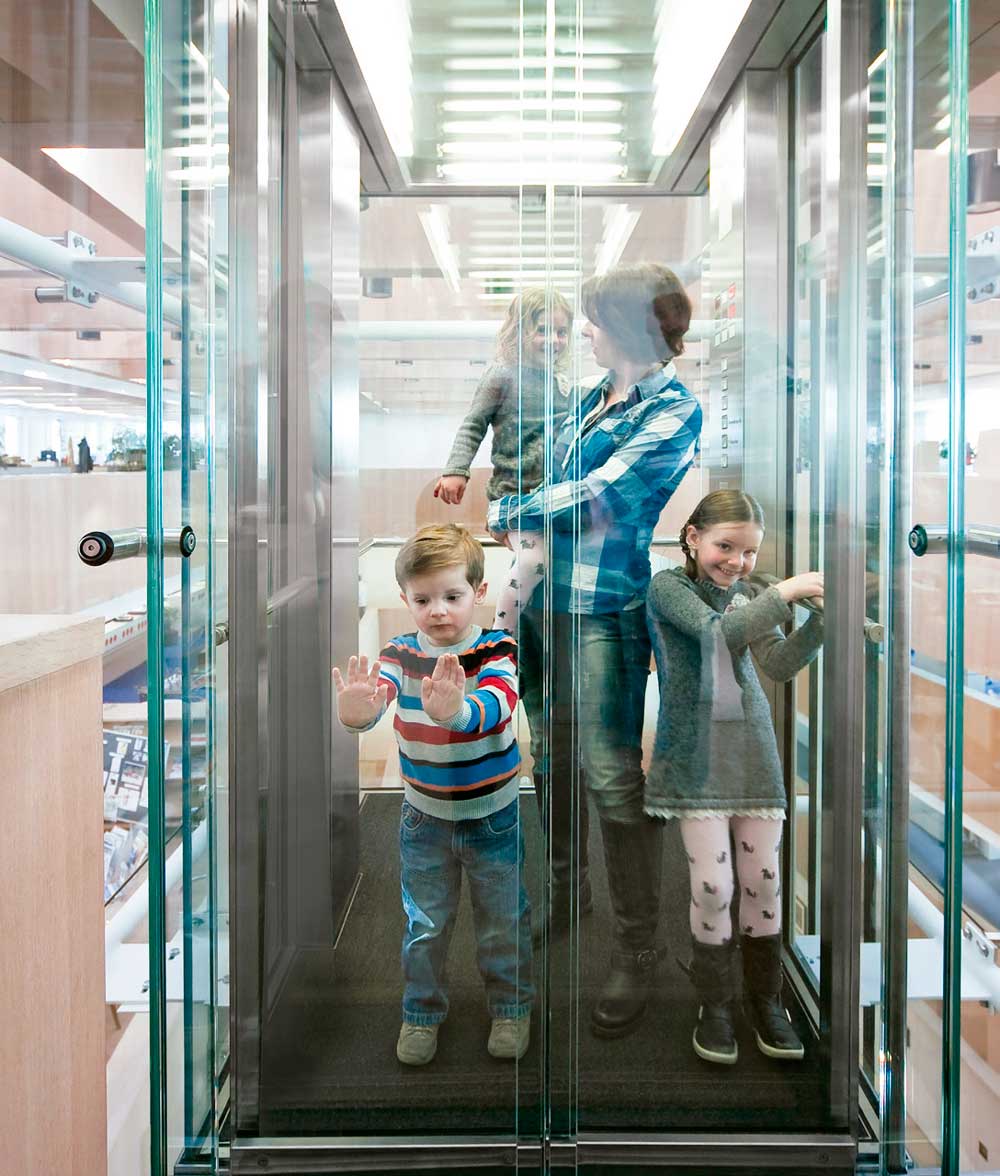Beware of Little Hands Getting Trapped in Glass Lift Doors
Jul 1, 2017

Children “look” with their hands, when doors may open suddenly.
In recent years, Liftinstituut received accident reports of children getting trapped in glass lift doors as their little hands were dragged along by the slip-resistant glass. The number of accidents reported to Liftinstituut is not indicative of reality, in which the figure is much higher. Therefore, we advise parents to see to it that their children do not put their hands on the glass lift doors. We also urge lift users and owners to take extra safety precautions.
Glass Is Getting Popular
Glass lifts are increasingly popular, not only because they are an attractive feature within a building or offer spectacular views, but also because the transparency makes lift users feel safe. This is why they are used in public locations, such as stations, shopping centers and multistory car parks, in particular. These are also places visited by parents with small children.
Occasional Serious Injury
During a lift ride, many children are inclined to put their hands on the glass lift doors to look down. When the doors subsequently open automatically, their hands may slide between the panels. The result is that their hands can be trapped and, sometimes, seriously injured. Data from a store chain showed that, yearly, 40 children get trapped in glass lift doors in their European stores. Although injury has remained limited to date, these are worrisome figures.
Distraction for Parents
The increase in the risk of getting hands trapped may be due to having distracting situations around the lift. For example, Liftinstituut was informed of a specific incident in which special offers were placed immediately next to the glass lift. When passing, parents focused their attention on the special offers, while their children were having a look at the lift. This led to numerous cases of hands getting trapped. It would be good if lift maintenance companies made store owners aware of the risks.
Use of Detection Still Limited
In view of the increased number of accidents, a solution has been developed within the lift industry for the prevention of entrapment in glass lift doors. This is often based on electronic detection. However, only limited use of this is being made so far. Therefore, Liftinstituut calls on lift owners and suppliers to investigate which technical solutions are achievable.
Other Prevention Technology
Meiler has a laser system that records when a little hand is about to get trapped. This will cause door movement to stop abruptly (i.e., at the very last moment). The laser is fitted above the doors (cage and/or shaft door) in the corner where the trapping may occur.
Lightspeed, represented by Mulder Montage from Alphen aan den Rijn in the Netherlands, uses the Lightspeed system for the prevention of little hands getting trapped. In the improved version, the glass filament is not only in the door edge, but also in the fixing of the door panel, in the frame with the guide rollers. This will cause the door movement to come to a halt as soon as a child puts a hand on the door while the door is closing. The system is, therefore, triggered earlier than in the old Lightspeed system and also earlier than in Meiler’s new system.
CEDES has developed a radar that detects movement near the closing lift door, which causes the door to reopen. This system is simple to fit, replacing a sensor frame. It also offers the option of counting the number of passengers getting into the lift. It comes in a 2D version (TOFgard/Mini), 3D version (TOFgard/3D) and count version (TOFgard/Counting).
As an alternative to CEDES’ comparable system, Memco has a radar that detects movements in front of lift doors. It has a cone-shaped beam that is said to pull back a little slower than other radar protection systems when the door closes.
Standardization-Prescribed Solutions
In older lift standards EN 81-1 and -2 from 1986, the hazard of glass doors was not covered. Likewise, in most older lifts (before 1998), no precautions were provided to prevent little hands from getting trapped when the lift doors automatically slide open. After all, this is not a requirement.
From harmonized standards EN 81-1 and -2 from 1998 onward, requirements were incorporated to reduce the risk of little hands getting trapped when glass lift doors slide open. Lifts commissioned from July 1, 1999, onward must comply with the following requirements from this standard:
“8.6.7.5 In order to prevent that little hands get trapped, automatically and mechanically driven horizontal sliding doors made from glass wider than 150mm* must be provided with facilities that minimise this risk, such as:
- a) reducing the friction rate between hands and glass;
- b) providing opaqueness to glass up to a height of 1.10m;
- c) detecting the presence of fingers; or
- d) other comparable methods.
* see standard section 7.6.2”
In respect of option d), lift manufacturers invented various solutions over the years, such as:
- Restricting gaps around glass doors to a maximum of 3 mm (around metal doors, a maximum of 10 mm is permitted)
- Fitting specially formed profiles in the gap between the doors and the frame, so the gaps are reduced, and the risk of getting trapped in the profile is diverted
The successor of the EN 81-20 standard prescribes the following solution in Section 5.3.6.2.2.1:
“In order to prevent that little hands get trapped, automatically and mechanically driven horizontal sliding doors made from glass wider than 150mm* must be provided with facilities that minimise this risk, by:
- making the glass opaque on the user’s side, by using either opaque glass or by applying an opaque coating up to a height of at least 1.10m, or
- detecting the presence of fingers up to a height of at least 1.60m above the threshold and stopping the opening movement of the door, or
- restricting the gap between the door panels and the frame to a maximum of 4mm up to a height of at least 1.60m above the threshold. With wear and tear, this value may increase to 5mm.
Indents (glass framing etc.) may not exceed 1mm and must be included in the 4mm gap. The maximum radius of the outer edge of the frame bordering on the door panel may not exceed 4mm.
* see standard section 5.3.7.2”
The option given in EN 81-1 and -2 for applying a coating to the glass to reduce the friction rate has been removed from EN 81-20, as this solution proved to work only very temporarily (i.e., until the window cleaner’s next visit).
Get more of Elevator World. Sign up for our free e-newsletter.









